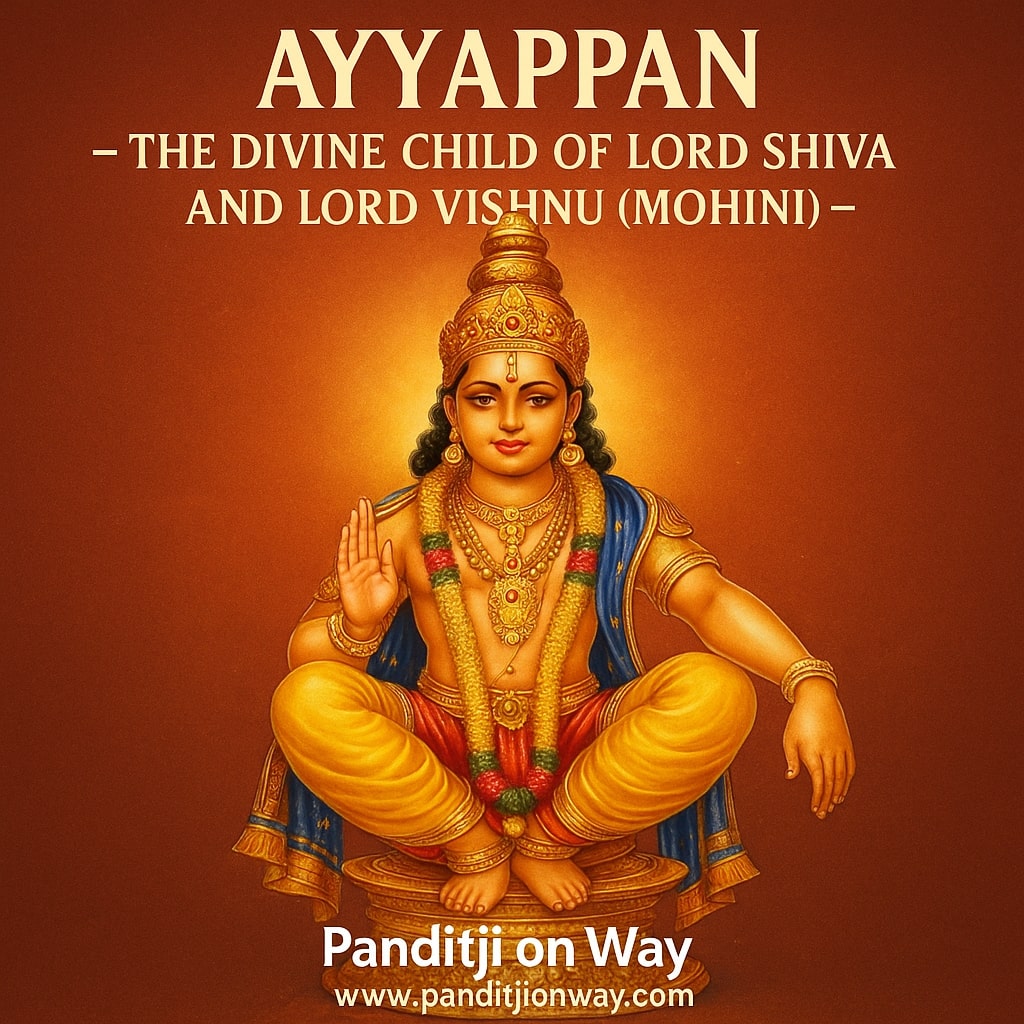Ayyappan – The Divine Child of Lord Shiva and Lord Vishnu (Mohini)
Lord Ayyappan, also known as Manikandan, is a revered Hindu deity born from the mystical union of Lord Shiva and Lord Vishnu in his female form, Mohini. His tale is deeply rooted in divine intervention, spiritual power, and the triumph of good over evil. Worshipped predominantly in South India, especially in Kerala, Lord Ayyappan is the presiding deity of the world-famous Sabarimala Temple. This blog explores his origin, life, divine mission, and the legendary pilgrimage that attracts millions of devotees annually.

Table of Contents
- The Enchanting Mohini Avatar of Lord Vishnu
- The Birth of Lord Ayyappan
- Childhood of Lord Ayyappa
- Ayyappa and the Battle with Mahishi
- The Divine Departure and Temple at Sabarimala
- Rituals and Worship of Lord Ayyappa
- The Famous Sabarimala Pilgrimage
- Conclusion: The Eternal Dharma Shastha
- FAQs on Lord Ayyappa
The Enchanting Mohini Avatar of Lord Vishnu
During the cosmic event of Samudra Manthan (Churning of the Ocean), both Devas and Asuras fought over the Amrita, the nectar of immortality. To safeguard the divine order, Lord Vishnu took the form of an enchanting damsel, Mohini, and cleverly distributed the nectar to the Devas by beguiling the Asuras.
In another episode from the Vishnu Purana, Mohini tricks the demon Bhasmasura, who had received a boon from Lord Shiva that allowed him to turn anyone to ashes by touching their head. Mohini lures him into a dance, mimics placing her hand on her head, and the demon unknowingly destroys himself.
The Birth of Lord Ayyappan – A Divine Intervention
After Mohini’s enchanting feats, Lord Shiva became curious and desired to meet her. Upon encountering Mohini, he was overwhelmed with divine desire. From this unique union of Lord Shiva and Mohini (Vishnu), Ayyappan was born—destined to defeat the powerful demoness Mahishi, who could only be slain by a child born of both Shiva and Vishnu due to a boon by Lord Brahma.
This divine birth fulfilled a cosmic prophecy, and thus, Hariharaputra (Son of Hari & Haran) came into being.
Childhood of Lord Ayyappa – The Rise of Manikandan
The divine infant was found on the banks of the Pampa River by King Rajashekhara of Pandalam, who named him Manikandan, as a golden bell (mani) was tied around his neck (kandan) by his celestial parents.
Raised as a prince, Manikandan excelled in martial arts, scriptures (shastras), and displayed miraculous powers. When asked for guru dakshina, he restored sight and speech to his guru’s blind and mute son—proving his divine nature.
Ayyappa and the Battle with Mahishi
When the queen conspired to make her biological son the heir instead of Manikandan, she faked an illness and demanded tigress’s milk as the cure. Manikandan, aware of his destiny, ventured into the forest to fetch it.
During his journey, he encountered Mahishi, a powerful demoness wreaking havoc in Devaloka. Realizing she was his destined foe, Manikandan engaged in a fierce battle and finally subdued her on the banks of the Azhutha River. His celestial dance of destruction frightened even the Devas. Realizing his divinity, Mahishi surrendered and attained moksha.
The Divine Departure and the Temple at Sabarimala
After his victory, Manikandan continued his mission and returned to Pandalam riding a tigress—actually Indra in disguise, accompanied by devas in tiger forms. He revealed his divine nature and insisted that his purpose on earth was complete.
When King Rajashekhara asked for a boon, Ayyappan instructed him to build a temple at Sabari, where Sage Sabari had waited for Lord Rama. Ayyappan shot an arrow, and the temple was established at the location it landed—Sabarimala.
The idol was carved and consecrated by Sage Parasurama on the auspicious day of Makar Sankranti.
Rituals and Worship of Lord Ayyappa
Devotees of Lord Ayyappa undertake a 41-day vratham (penance), practicing:
- Complete celibacy
- Wearing black or blue clothes
- Bathing in holy water, especially the Pampa River
- Chanting “Swamiye Saranam Ayyappa”
- Carrying the Irumudi Kettu with offerings
- Climbing the sacred 18 steps barefoot
The journey signifies inner purification and spiritual awakening.
The Famous Sabarimala Pilgrimage
The Sabarimala Temple, nestled in the dense forests of Pathanamthitta district, Kerala, is one of the largest annual pilgrimage sites in the world. Over 50 million devotees from across India visit during Mandala season (Nov-Jan).
The climax of the pilgrimage occurs on Makar Sankranti (January 14th), when devotees witness the Makara Jyothi—a divine light appearing on the hill, symbolizing Lord Ayyappa’s presence.
📍 Location: Sabarimala Temple – Google Maps
Frequently Asked Questions About Lord Ayyappan
Who is Lord Ayyappan and what is his origin?
Lord Ayyappan, also known as Hariharaputra, is the divine son of Lord Shiva and Lord Vishnu, born when Vishnu took the form of Mohini. He was born to destroy the demoness Mahishi, who could only be defeated by a child born from both these deities.
What is the story behind Lord Ayyappan and Mahishi?
Mahishi was a demoness with a boon from Lord Brahma that made her invincible to everyone except the child born of Shiva and Vishnu. Lord Ayyappa, born from the union of Shiva and Mohini, fulfilled the prophecy by defeating Mahishi after a fierce battle near the Azhutha River, thus restoring cosmic balance.
Why is Lord Ayyappan called Manikandan?
Lord Ayyappa is called Manikandan because when he was found on the banks of the Pampa River by King Rajashekhara of Pandalam, he had a divine golden bell (mani) tied around his neck (kandan), gifted by his celestial parents.
What is the importance of the 41-day Ayyappa vratham?
The 41-day Ayyappa vratham or penance is observed by devotees to purify the body and mind before visiting Sabarimala Temple. During this period, they live a celibate life, wear black clothes, chant “Swamiye Saranam Ayyappa,” and maintain strict discipline, which prepares them spiritually for the holy pilgrimage.
When should I visit Sabarimala Temple in 2025?
The best time to visit Sabarimala Temple in 2025 is during the Mandala Kalam (mid-November to mid-January). The peak event is on January 14, 2025, during Makar Sankranti, when lakhs of devotees gather to witness the Makara Jyothi, a celestial light symbolizing Lord Ayyappa’s divine presence.
What are the 18 sacred steps (Pathinettam Padi) in Sabarimala?
The 18 steps at Sabarimala Temple, known as Pathinettam Padi, represent 18 elements like ego, desire, knowledge, and senses. Only those who have completed the 41-day vratham and carry the Irumudi Kettu (sacred offering bundle) are allowed to climb these steps, signifying spiritual ascension.
Why do Ayyappan devotees wear black clothes and go barefoot?
Ayyappa devotees wear black or blue clothes and walk barefoot to signify humility, detachment, and surrender to the divine. The practice symbolizes renunciation of material pleasures and a commitment to a pure, disciplined lifestyle during the vratham period.
Can women visit Sabarimala Temple?
As of current tradition, women between the ages of 10 and 50 are restricted from entering the Sabarimala Temple, as Lord Ayyappan is considered a Naishtika Brahmachari (eternal celibate). However, the topic remains under legal and social debate in India.
What does “Swamiye Saranam Ayyappa” mean?
“Swamiye Saranam Ayyappa” is the primary chant of Ayyappa devotees. It translates to “Oh Lord Ayyappa, I surrender at your feet,” reflecting devotion, surrender, and the acceptance of divine will throughout the pilgrimage.
How can I book a Pandit for Lord Ayyappa Vratham or Puja?
You can easily book a qualified Pandit for Lord Ayyappan Vratham, Ayyappa Puja, or Mandala rituals through PanditJiOnWay.com – India’s trusted platform for verified and Vedic Pandits for all religious services.
The best time is during Mandala season (Nov-Jan), especially on Makar Sankranti (January 14, 2025).
- Durga Saptashati Path Services – panditjionway.com
- Chandi Path for Evil Removal – panditjionway.com
- Book a Pandit for Puja – panditjionway.com
- Wikipedia – Ayyappan
Swamiye Saranam Ayyappa!
For personalized puja services and guidance on observing Lord Ayyappa’s vratham, visit PanditJiOnWay.com and book an experienced pandit today.
Conclusion: The Eternal Dharma Shastha
Lord Ayyappa is not just a deity but a symbol of unity, discipline, and devotion. His life teaches us the values of sacrifice, truth, and divine justice. As the protector of Dharma (righteousness) and destroyer of ego and evil, Lord Ayyappan continues to bless millions on their spiritual path.


